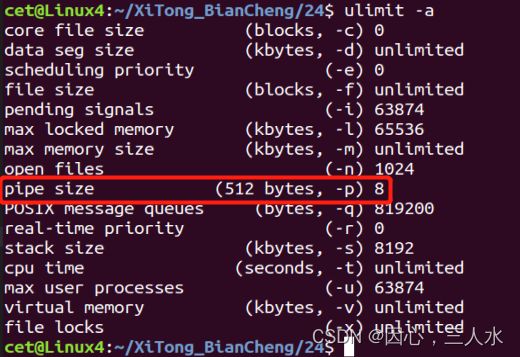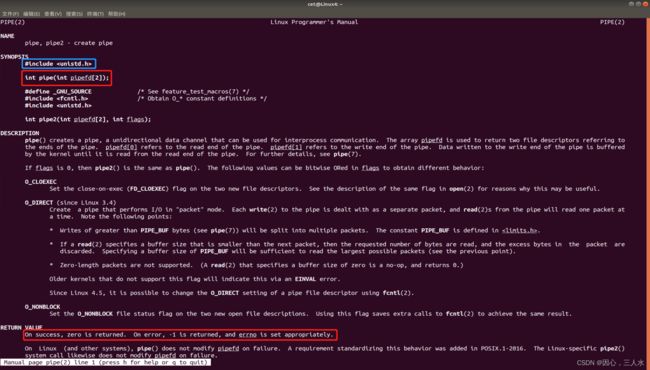【Linux系统编程】24.管道、pipe、fifo、进程间文件通信
目录
管道
实现原理
特质
局限性
读写行为
读管道
写管道
缓冲区大小
返回值
优缺点
优点
缺点
pipe
参数pipefd[2]
返回值
测试代码1
测试结果
测试代码2
测试结果
测试代码3
测试结果
fifo
创建方式
参数pathname
参数mode
返回值
测试代码4
测试结果
测试代码5
测试结果
进程间文件通信
测试代码6
测试结果
管道
实现原理
内核戒指环形队列机制,使用内核缓冲区实现,较为简单。
特质
伪文件。
管道中的数据只能一次读取。
数据在管道中,只能单向流动。
局限性
只能自己写,不能自己读。
数据不可以反复读。
半双工通信。
血缘关系进程间可用。
读写行为
读管道
管道有数据:read返回实际读到的字节数。
管道无数据:
写端全部关闭,read函数返回0。
写端不关闭,read函数阻塞等待。
写管道
读端全部关闭,异常终止,SIGPIPE信号导致。
读端不关闭:
管道数据已满,阻塞等待。
管道数据未满,返回写出的字节个数。
缓冲区大小
ulimit -aman 3 fpathconf返回值
成功:管道的大小。
失败:-1。
优缺点
优点
管道相比信号,套接字实现进程间通信,简单很多。
缺点
只能单向通信,双向通信需建立两个管道。
只能用于父子、兄弟进程(有共同祖先)间通信。该问题后来使用fifo有名管道解决。
pipe
创建并打开管道。
man 2 pipe参数pipefd[2]
pipefd[0]:读端。
pipefd[1]:写端。
返回值
成功:0
失败:-1
测试代码1
父进程用管道写内容,子进程用管道读内容,将读取到内容输出到终端上。
#include
#include
#include
#include
#include
int main(int argc, char *argv[])
{
int GuanDao_flag; //管道标志位
int pipefd[2];
char data[1024]; //接收的数据
int leng; //接收数据的长度
pid_t JinCheng_ID; //进程ID
printf("程序开始运行!\n");
printf("当前进程的ID是%d。\n", getpid());
printf("开始创建管道!\n");
GuanDao_flag = pipe(pipefd); //创建管道
if (GuanDao_flag == -1)
{
perror("创建管道错误");
}
printf("开始创建进程!\n");
JinCheng_ID = fork();
if (JinCheng_ID > 0) //父进程
{
printf("这是父进程,当前进程的ID是%d,子进程ID是%d。\n", getpid(), JinCheng_ID);
close(pipefd[0]); //关闭读端
write(pipefd[1], "你好,世界!\n", strlen("你好,世界!\n")); //通过管道向子进程发送数据
sleep(1);
close(pipefd[1]);
printf("这是父进程,父进程结束。\n");
}
else if (JinCheng_ID == 0) //子进程
{
printf("这是子进程,当前进程的ID是%d,父进程ID是%d。\n", getpid(), getppid());
close(pipefd[1]); //子进程关闭写端
leng = read(pipefd[0], data, sizeof(data)); //接收父进程发送的数据
write(STDOUT_FILENO, data, leng); //将数据写到终端上
close(pipefd[0]);
printf("这是子进程,子进程结束。\n");
}
return 0;
} 测试结果
测试代码2
用管道实现ls | wc -l命令。
#include
#include
#include
#include
#include
int main(int argc, char *argv[])
{
int GuanDao_flag; //管道标志位
int pipefd[2];
char data[1024]; //接收的数据
int leng; //接收数据的长度
pid_t JinCheng_ID; //进程ID
printf("程序开始运行!\n");
printf("当前进程的ID是%d。\n", getpid());
printf("开始创建管道!\n");
GuanDao_flag = pipe(pipefd); //创建管道
if (GuanDao_flag == -1)
{
perror("创建管道错误");
exit(1);
}
printf("创建管道完成!\n");
printf("开始创建进程!\n");
JinCheng_ID = fork();
if (JinCheng_ID == 0) //子进程
{
printf("这是子进程,当前进程的ID是%d,父进程ID是%d。\n", getpid(), getppid());
close(pipefd[1]); //子进程关闭写端
dup2(pipefd[0], STDIN_FILENO); //终端输入重定向到管道的读端
execlp("wc", "wc", "-l", NULL);
perror("子进程错误");
}
else if (JinCheng_ID > 0) //父进程
{
printf("这是父进程,当前进程的ID是%d,子进程ID是%d。\n", getpid(), JinCheng_ID);
close(pipefd[0]); //关闭读端
dup2(pipefd[1], STDOUT_FILENO); //终端输出重定向到管道的写端
execlp("ls", "ls", NULL);
perror("父进程错误");
}
else if (JinCheng_ID == -1)
{
perror("创建进程错误");
exit(1);
}
return 0;
} 测试结果
测试代码3
使用兄弟进程间实现ls | wc -l命令。
#include
#include
#include
#include
#include
#include
int main(int argc, char *argv[])
{
int GuanDao_flag; //管道标志位
int pipefd[2];
pid_t JinCheng_ID; //进程ID
int i;
printf("程序开始运行!\n");
printf("当前进程的ID是%d。\n", getpid());
printf("开始创建管道!\n");
GuanDao_flag = pipe(pipefd); //创建管道
if (GuanDao_flag == -1)
{
perror("创建管道错误");
exit(1);
}
printf("创建管道完成!\n");
printf("开始创建进程!\n");
for (i = 0; i < 2; i++)
{
JinCheng_ID = fork();
if (JinCheng_ID == -1)
{
perror("创建进程错误");
exit(1);
}
else if (JinCheng_ID == 0) //子进程
{
break;
}
}
if(i==0){
printf("这是子1进程,当前进程的ID是%d,父进程ID是%d。\n", getpid(), getppid());
close(pipefd[0]); //子1进程关闭读端
dup2(pipefd[1], STDOUT_FILENO); //终端输出重定向到管道的写端
execlp("ls", "ls", NULL);
perror("子1进程错误");
}
else if(i==1){
printf("这是子2进程,当前进程的ID是%d,父进程ID是%d。\n", getpid(), getppid());
close(pipefd[1]); //子2进程关闭写端
dup2(pipefd[0], STDIN_FILENO); //终端输入重定向到管道的读端
execlp("wc", "wc", "-l", NULL);
perror("子进程错误");
}
else if(i==2){
printf("这是父进程,当前进程的ID是%d。\n", getpid());
close(pipefd[0]); //父进程关闭读端、写端,保证兄弟进程之间形成单向通信
close(pipefd[1]);
wait(NULL);
wait(NULL);
printf("父进程结束。\n");
}
return 0;
} 测试结果
fifo
FIFO常被称为命名管道,以区分管道(pipe)。管道(pipe)只能用于“有血缘关系”的进程间。但通过FIFO,不相关的进程也能交换数据。 FIFO文件在磁盘上没有数据块,仅仅用来标识内核中一条通道。各进程可以打开这个文件进read/write,实际上是在读写内核通道,实现了进程间通信。
创建方式
mkfifo 管道文件名man 3 mkfifo参数pathname
管道文件名。
参数mode
管道文件权限。
返回值
成功:0
失败:-1
测试代码4
使用mkfifo创建一个管道文件。
#include
#include
#include
#include
#include
#include
int main(int argc, char *argv[])
{
int flag;
flag=mkfifo("GuanDao",0664);
if(flag==-1){
perror("创建管道文件错误");
}
return 0;
} 测试结果
测试代码5
利用管道,将两个毫无相关的进程进行连接通信。
/*
CeShi5_1.c
接收CeShi5_2进程的数据
*/
#include
#include
#include
#include
#include
int main(int argc, char *argv[])
{
int fd, leng;
char data[4096];
printf("程序开始运行。\n");
printf("开始打开管道文件的读端。\n");
fd = open(argv[1], O_RDONLY);
if (fd == -1)
{
perror("打开管道文件错误");
exit(1);
}
printf("打开管道文件的读端完成。\n");
printf("开始读取管道文件读端的数据。\n");
while (1)
{
leng = read(fd, data, sizeof(data));
if (leng > 0)
{
//printf("读取到数据为:");
write(STDOUT_FILENO, "读取到数据为:", strlen("读取到数据为:"));
write(STDOUT_FILENO, data, leng);
}
}
close(fd);
return 0;
} /*
CeShi5_2.c
向CeShi5_1进程发送数据
*/
#include
#include
#include
#include
#include
int main(int argc, char *argv[])
{
int fd, i;
char data[4096];
printf("程序开始运行。\n");
printf("开始打开管道文件的写端。\n");
fd = open(argv[1], O_WRONLY);
if (fd == -1)
{
perror("打开管道文件错误");
exit(1);
}
printf("打开管道文件的写端完成。\n");
printf("开始向管道文件写端写数据。\n");
i = 1;
while (1)
{
sprintf(data, "你好,世界!这是写进程第%d次向管道写端写数据。\n", i);
write(fd, data, strlen(data));
printf("第%d次写成功。\n", i);
i++;
sleep(1);
}
close(fd);
return 0;
} 测试结果
进程间文件通信
使用文件完成毫无关系进程间的通信。
测试代码6
/*
CeShi6_1.c
优先执行数据的写入文件
*/
#include
#include
#include
#include
#include
int main(int argc, char *argv[])
{
int fd, flag;
char *data = "你好,世界!这是CeShi6_1进程写的。\n";
char data1[1024];
int leng;
printf("程序开始运行。\n");
printf("开始打开文件。\n");
fd = open("temp.txt", O_RDWR | O_TRUNC | O_CREAT, 0664);
if (fd == -1)
{
perror("打开文件错误");
exit(1);
}
printf("打开文件完成。\n");
printf("开始文件写数据。\n");
write(fd, data, strlen(data));
printf("写的数据是:%s", data);
printf("文件写数据完成。\n");
printf("开始睡大觉。\n");
sleep(5);
printf("睡醒了,康康文件的数据。\n");
lseek(fd, 0, SEEK_SET); //设置偏移量从头开始
leng = read(fd, data1, sizeof(data1));
flag=write(STDOUT_FILENO,data1,leng);
if(flag==-1){
perror("输出错误");
exit(1);
}
printf("我真是服了,把我数据给改了,CeShi6_2你个老6。\n");
close(fd);
return 0;
} /*
CeShi6_2.c
读取文件数据和修改文件数据
*/
#include
#include
#include
#include
#include
int main(int argc, char *argv[])
{
int fd, flag;
char *data = "你好,世界!这是CeShi6_2进程写的。\n";
char data1[1024];
int leng;
printf("程序开始运行。\n");
printf("开始睡大觉。\n");
sleep(2);
printf("睡醒了,我是老6,把你CeShi6_1进程写的数据给改了。\n");
printf("开始打开文件。\n");
fd = open("temp.txt", O_RDWR);
if (fd == -1)
{
perror("打开文件错误");
exit(1);
}
printf("打开文件完成。\n");
printf("让我康康你写了啥。\n");
leng = read(fd, data1, sizeof(data1));
write(STDOUT_FILENO, data1, leng);
printf("哦豁,写了这玩意。\n");
printf("开始文件写数据。\n");
lseek(fd, 0, SEEK_SET); //设置偏移量从头开始
write(fd, data, strlen(data));
printf("写的数据是:%s", data);
printf("文件写数据完成。\n");
close(fd);
return 0;
} 








